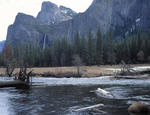National Park Service
U.S. Department of the Interior
Yellowstone National Park
P.O. Box 168
Yellowstone National Park, WY 82190
FOR IMMEDIATE RELEASE
September 11, 2009 09-081
Al Nash or Stacy Vallie (307) 344-2015
Yellowstone’s Summer 2009 Bison Population Estimate Released
Yellowstone National Park has completed a bison population abundance estimate.
The population is estimated to be 3,300 bison. The estimate is based on a series of aerial surveys conducted in June and July.
The population now includes 2,800 adult and yearling bison, and 500 calves of the year. The population is about equally distributed between the Central Interior and Northern Range herds.
The population was estimated at 3,000 bison last summer; and at 2,900 adult and yearling bison in late winter. The peak population estimate of 4,900 bison was recorded in the summer 2005.
The observed rate of population change this past year is within the natural range of expectation for wild bison. The rate at which wildlife populations increase in abundance is a reflection of the combined effects of reproduction and mortality, and is heavily influenced by age structure of the population, and habitat conditions encountered over the course of time.
This population estimate is used to inform adaptive management strategies under the Interagency Bison Management Plan (IBMP). Specific management actions may be modified based on expected late winter population levels as corroborated by the summer population estimate.
The IBMP is a cooperative plan designed to conserve a viable, wild bison population while protecting Montana’s brucellosis-free status.
The five cooperating agencies operating under the IBMP are the National Park Service, the U.S. Forest Service, the Animal and Plant Health Inspection Service, the Montana Department of Livestock, and the Montana Department of Fish, Wildlife and Parks.
Yellowstone’s Summer 2009 Bison Population Estimate Released
All posts are those of the individual authors and the owner
of this site does not endorse them. Content should be considered opinion
and not fact until verified independently.
Sorry, only registered users may post in this forum.


